Afghans see change in U.S. command as a threat to safety
- Share via
Reporting from Kabul, Afghanistan — It can be a split-second decision, or one that plays out over long and agonizing hours: to kill or not to kill.
“Rules of engagement” is the dry, legalistic term for the visceral battlefield calculus of when and whether to use deadly force to counter threat, real or perceived. Across Afghanistan, these rules serve as the marching orders that govern Western troops’ daily encounters with Taliban fighters and color dealings with Afghan civilians.
U.S. Army Gen. David H. Petraeus, who on Sunday formally took command of Western forces here, must decide in the coming weeks or months whether to recalibrate the stringent rules of engagement laid down last summer by his predecessor, Gen. Stanley A. McChrystal, who recently resigned over remarks that laid bare a dysfunctional civilian-military relationship.
Of Petraeus’ early command decisions, this will be among the most closely watched, not only by Afghan civilians, but by his own troops in the field. So far, he has struck a delicate balance in public remarks about the issue.
At his Senate confirmation hearings last week, Petraeus said he foresaw no major shift in strategy in the Afghanistan war. But he has made it clear that even if the rules of engagement do not change, the nuances of how they are implemented will get a close new look.
Assuming command Sunday, Petraeus told his troops that while civilian safety remains a critical consideration, “as you and our Afghan partners on the ground get into tough situations, we must employ all assets to ensure your safety.”
It was a remark apparently intended to reassure troops that the safeguarding of Afghans was not to come at the expense of military lives.
When McChrystal took over as commander in June 2009, foreign forces in Afghanistan were the accidental cause of nearly as many civilian deaths as were the insurgents, who often deliberately put noncombatants in harm’s way.
McChrystal set out to change that and was credited with bringing about a substantial drop in the proportion of civilian casualties suffered at the hands of NATO’s International Security Assistance Force and its Afghan allies.
Under the procedures put in place last summer, commanders could not fire on buildings or other sites where they had reason to think civilians might be present unless their own forces were in imminent danger of being overrun. And even then, they were told to break off engagements and withdraw rather than risk harming noncombatants.
Few in or outside the military contested McChrystal’s underlying premise that civilian deaths caused by the West are highly counterproductive because they galvanize public fury and thus help bolster support for the Taliban. Alienating the townspeople and villagers who live in battle zones flies in the face of the United States’ counterinsurgency strategy — one that bears the stamp of not only McChrystal but also Petraeus, and is centered on winning Afghan hearts and minds.
For months there has been grumbling in the ranks that the rules of engagement can sometimes hamper the ability of Western troops, who include nearly 100,000 Americans, to even defend themselves, let alone move aggressively against a determined enemy.
In the heat of battle, the restrictions can diminish to the vanishing point the American advantages of superior firepower and technology, some field commanders say, thus leaving small units particularly vulnerable.
The change of command in Afghanistan has civilians worried that it will be even more dangerous to come into contact with the foreign forces in their midst. Already, many motorists freeze with anxiety at the sight of a Western convoy or when coming up on a military checkpoint, fearing they will be taken for would-be suicide attackers and shot.
Civilian casualties have been a particularly sensitive issue between the Western coalition and Afghan President Hamid Karzai. Petraeus has already given Karzai his personal pledge that preventing civilian deaths will continue to be a top priority, presidential aides said.
Sunday, though, brought a fresh reminder that for civilians, the insurgency usually poses the greatest threat to life and limb.
In southern Afghanistan’s restive Helmand province, Afghan security forces were summoned to deal with an urgent threat: a bomb that had been planted on a donkey — the ubiquitous beast of burden here — in a bazaar in the district center of Musa Qala.
As the explosive device was being disabled, another bomb affixed to a motorcycle went off elsewhere in the bazaar, said provincial spokesman Daoud Ahmadi. Four people, some of them said to be young children, were killed and six others were wounded.
In Washington on Sunday, Said Jawad, the Afghan ambassador to the U.S., said the war is continuing in part because of “lack of proper cooperation in the region, lack of full commitment on the part of the NATO countries, and other things.”
He added that the war will still “take some time” and that “we have made a lot of progress but the enemy is brutal. The threat of terrorism is still imminent.... We cannot kill every bad guy in Afghanistan.”
Times staff writer Richard A. Serrano in Washington contributed to this report.
More to Read
Sign up for Essential California
The most important California stories and recommendations in your inbox every morning.
You may occasionally receive promotional content from the Los Angeles Times.










